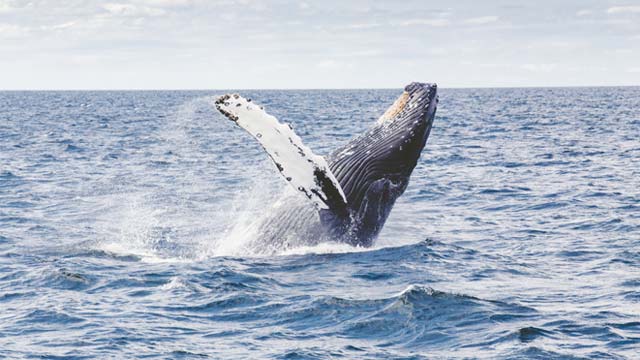One of the grandest sights in nature is to behold a 60,000-pound gray whale breaching over the blue waters of the Pacific Ocean. When accompanied by their young or traveling together with other adults in a pod, it can be a memory you’ll treasure for years. In short, whale watching in Oregon is fastastic. The natural beauty of its rugged, emerald coastline is an ideal complement to witnessing the 12,000-mile migration of these magnificent marine mammals.
While often elusive, whales don’t spend all of their time under the water. Whales get their oxygen from the air, just like you and I. Did you know that the commonly sighted gray whales have double spouts and that their blow is not a fountain of water, but mist resulting from the warm air they exhale under high pressure? Their diving cycle is also rhythmic – a few short dives of less than a minute then followed by a longer dive of three to six minutes.
There are many ways to spot these gentle giants, and we’re going to share with you some of the best vantage points around Florence, Oregon, as well as some of the ideal times for you to set out on your adventure.
The Migration
Each year, around 18,000 whales migrate from their summer home in the brisk seas surrounding Alaska down to their winter breeding grounds off the coast of Mexico. These warmer waters serve as ideal nurseries for mothers and their newborn calves. In the springtime, new whale families make the return voyage back up to Alaska. Some 200 whales enjoy the mild climate of Oregon so much that they make the Oregon coast their final summer destination and will feed roughly five miles offshore.
When heading south for the winter, the whales take a direct path down to Mexico, moving quickly to arrive at their destination in time. You may spot up to 30 whales passing by per hour on this leg of their journey. On the way back, however, they tend to take a more leisurely pace, allowing their young to keep pace. Viewing mothers with their calves typically doesn’t take place until May.
Location, Location, Location
With so many beaches and viewpoints along Oregon’s 363-mile coastline, the number of locations to whale watch can leave you wondering where to start. Depending on your level of comfort, there are plenty of options to suit your tastes. Indoor viewing can take place at several restaurants and hotels right on the central Oregon shoreline. Some ideal outdoor vantage points around Florence include:
- Sea Lion Caves Turnout
- Heceta Head Lighthouse State Scenic Viewpoint
- Devil’s Churn Viewpoint
- Cook’s Chasm Turnout
- Cape Perpetua – the highest point on the Oregon Coast
If you’re stopping at the Sea Lion Caves in spring or summer, you may even spot orcas (aka killer whales) prowling the waters nearby. If you want to explore more of the coastline, Depoe Bay, just an hour and a half north of Florence, is also known as the whale watching capital of the coast.
For those wanting to experience whale migrations from a different vantage point, there are options, such as going by boat or by plane. Cruises are available to charter outside of Newport, which is about an hour north of Florence. Additionally, you can choose to view things from above, with several air tours. One great option departing directly out of Florence is Aero Legends, the famous bright yellow WWII biplane. Most flights will accommodate between 1 to 3 passengers and are dependent on weather conditions. The ideal time to take one of these boat or plane excursions is between spring and fall when waters and skies are smoothest.
Choosing the Right Time
You’re most likely to see the highest number of whales swimming along the Oregon coast during mid-December through mid-January when they make their southward migration, and once again in March through June, when they return north. There are smaller populations that pass by in the other summer months and into early fall.
Spring Whale Watch Week (typically late March) holds a special treat for visitors, with hundreds of trained volunteers from the state’s Whale Watching Spoken Here program ready to assist in spotting migrating whales. Look out for their blue and white signs at 26 different viewing sites along the Oregon coast. Locations closest to Florence include the Sea Lion Caves and Cook’s Chasm. You’ll see them on hand usually between 10 a.m. and 1 p.m. daily.
For further information, you can contact (541) 765-3407, email whale.watching@state.or.us or visit www.whalespoken.org.
Other Helpful Tips
When you are in search of whales, remember you’re more likely to see that sudden vertical puff of mist from their spouts in the morning light, when the sun is behind you. Remember that whale watching can be like star gazing – if you keep your focus in only one place, you’re likely to miss something happening just outside your field of focus. Scan from one direction to the other, then do the same closer to shore or farther out toward the horizon. Having binoculars or a telephoto lens on a camera can be a great aid in spotting these creatures.
Heading out in the afternoon will reduce the contrast between whales on the surface of the water and the sunlight reflecting off the contours on the ocean, making whales more challenging to spot. Generally, higher locations are going to afford you a better view of whales and their blowholes than low-lying beaches. If you do choose to head out to a beach or low-lying rocky outcrop, be aware of sneaker waves, which can present real danger, and are known for sweeping people off their feet.
There are many locations around Florence to go whale watching in oregon. With just a little planning and patience, you’re likely to be rewarded with an unforgettable experience and with memories that will last for years to come.

